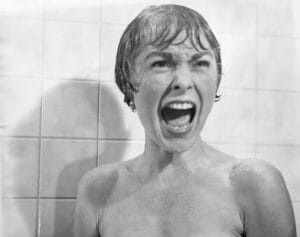(BestClips, 2018)
This clip from Halloween (Carpenter, 1978) shows the final conflict between protagonist Laurie and antagonist Michael. This scene strongly reinforces the concept of “final girl”, which Carol J. Clover introduced in their 1987 essay Her Body, Himself: Gender in the Slasher Film. “The image of the distressed female most likely to linger in memory is the image of one who did not die: the survivor, or Final Girl” (p. 201). Instead of the ‘final girl’ dying, she is able to fight back and, although an outside character comes to her aid, wins the conflict. Clover suggests this set a precedent for future slasher horror’s (p. 202).
The scene employs a typical approach to the soundtrack for the build-up and release of suspense. A repetitive motif of only a handful of notes is heard, which gradually gets more intense and is joined by stringed instruments which also gradually get more intense until the release when Michael attacks.
Carpenter creates a sense of claustrophobia in the scene as much of the action takes place within doorways and the closet. It feels as if the camera has been forced into the closet and is directly in front of the actor’s faces for the close-up shots, creating a real sense of unease for an audience, who wouldn’t dare step away because the hero can’t.
Production contexts linking the scene to the horror genre
It is a little difficult to link Halloween to historical slasher horror films, as it is commonly said that the film is what inspired many slasher horrors which came after.

Carpenter deliberately chose against having an excess of blood and gore in Halloween, as he wanted the story to be character driven. This was echoed by critics and reviewers: “Carpenter creates excellent tension throughout and he avoids excessive blood and gore in the murder sequences. The violent actions are mostly implied more than graphically depicted, which serves to heighten the effect” (Pennington, 2014). Jaws and The Shining (Kubrick, 1980) are other examples of a character driven horror.
Links between this scene and theoretical approaches to the horror genre
Two main links you can make are with Freud’s uncanny or unheimlich and Todorov’s uncanny or marvellous.
This scene links well with Freud’s theory of unheimlich. “Indeed, we have heard that in some modern languages the German phrase ein unheimliches Haus [‘an uncanny house’] can be rendered only by the periphrasis ‘a haunted house’.” (Freud, 2003, p. 148). Whilst the house in this scene certainly isn’t haunted, the uncanny feeling surrounds it – the house should be a safe place and comfortable, yet Laurie is literally fighting for survival.
“We can also call a living person uncanny, that is to say, when we credit him with evil intent. But this alone is not enough: it must be added that this intent to harm us is realized with the help of special powers.” (Freud, 2003, p.149). This applies well to Michael. Laurie stabs him with the knitting needle, and he is presumed dead – she then stabs him with the kitchen knife, and he is once again presumed dead. And finally, he is shot five times and falls from the first-floor window, presumed dead, but mysteriously disappears. One can only assume a form of special power may be guiding him and it certainly leaves the audience with a sense of unease, or uncanny.
This also ties in with Todorov’s theory of the fantastic. “In a world which is indeed our world, the one we know, a world without devils, sylphides, or vampires, there occurs an event which cannot be explained by the laws of this same familiar world.” (Todorov, 1995, p. 25). Furthermore, this enables the audience to draw their own conclusions to Michael’s fate.
“If the group of themes of the other derives directly from taboos and hence from censorship, the same is the case for the network of themes of the self, though less directly […] The thought of the psychotic is condemned by society no less severely than behavior of the criminal who transgresses taboos” (Todorov, 1995, p. 159). This ties in with earlier scenes in the film – Laurie’s friends have been involved in “taboo” activities and have been punished because of this, but Laurie was not and therefore she survives.
- BestClips. (2018, Oct 27). Michael Myers Unmasked – Ending Scene – Halloween (1978) Movie Clip HD [Video]. YouTube. https://youtu.be/OxRc3Z-pAqc
- Carpenter, J. (Director). (1978). Halloween. [Film]. Compass International Pictures.
- Clover, C. J. (1987). Her Body, Himself: Gender in the Slasher Film. Representations, 20, 187-228.
- Freud, S. (2003). The Uncanny (3rd ed.). Penguin Group.
- [Halloween poster]. (n.d.). Retrieved 22 January 2025, from https://www.imdb.com/title/tt0077651/mediaviewer/rm650516224
- Hitchcock, A. (Director). (1960). Psycho. [Film]. Shamley Productions.
- [Janet Leigh in Psycho (1960)]. (n.d.). Retrieved 22 January 2025, from https://www.imdb.com/title/tt0054215/mediaviewer/rm662150657
- Kubrick, S. (Director). (1980). The Shining. [Film]. Warner Bros; Hawk Films; Peregrine.
- Pennington, R. (2014, November 1). ‘Halloween’: THR’s 1978 Review. The Hollywood Reporter. https://www.hollywoodreporter.com/movies/movie-news/halloween-1978-film-review-745577/
- Spielberg, S. (Director). (1975). Jaws. [Film]. Zanuck/Brown Productions; Universal Pictures.
- Todorov, T. (1995). The Fantastic: A Structural Approach to a Literary Genre (6th ed.). Cornell University Press.
APA7
Cable, J. (2025, Mar 18). Genre characteristics in Halloween (1978). JCableMedia.com. https://www.jcablemedia.com/2025/03/18/genre-characteristics-in-halloween-1978/.
Chicago
Cable, John. “Genre characteristics in Halloween (1978).” JCableMedia.com. March 18, 2025. https://www.jcablemedia.com/2025/03/18/genre-characteristics-in-halloween-1978/.
Harvard
Cable, J. (2025). Genre characteristics in Halloween (1978). Available at: https://www.jcablemedia.com/2025/03/18/genre-characteristics-in-halloween-1978/ (Accessed: 03 April 2025).